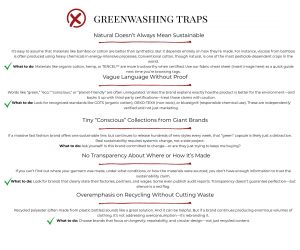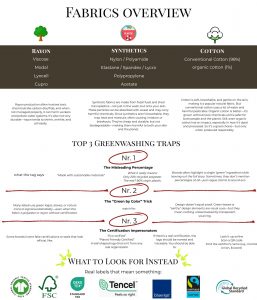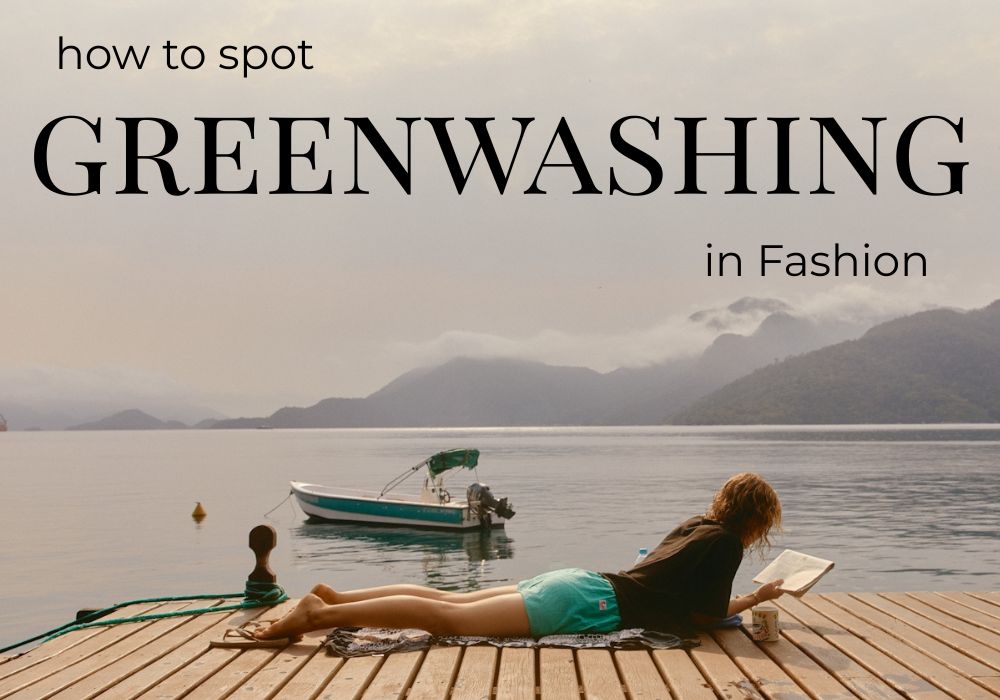Because real sustainability shouldn’t be this hard to find.
Not long ago, I stood in front of a rack of neatly folded sweatshirts at a well-known high-street store. One of them was labeled “eco-conscious collection”, dyed in a gentle moss green and made of something called “sustainable viscose.” It looked responsible. Ethical, even. But when I checked the fine print, my heart sank. No certifications. No explanation. And most importantly—no proof.
If you’ve ever felt like that, you’re not alone.
So many of us want to make better choices. We’re ready to invest more, to slow down, to buy fewer but better things. But the fashion world doesn’t make it easy. In fact, it often confuses us on purpose. That’s greenwashing—and it’s everywhere.
This guide is for you if you care deeply about how your clothes are made, but sometimes hesitate at the moment of purchase because you’re unsure if the “sustainable” label really means what it claims. Let’s make things clearer.

What Is Greenwashing—and Why It’s a Problem
Greenwashing is when a brand spends more time and money marketing itself as sustainable than actually reducing its environmental or social impact. It’s a story sold to us, not a change made for the planet.
And it’s not just a moral issue. It’s also financial. Sustainable fashion often costs more—because fair wages, safer chemicals, and slower production take more care and investment. That extra cost can be worth it. But when the product doesn’t live up to its claims, we’re not only wasting money—we’re being misled.
5 Signs That a “Sustainable” Label Isn’t Telling the Truth
Here are five red flags to watch for—so you can shop with more confidence and less guesswork.
 So How Do You Buy Better—Without Doubt?
So How Do You Buy Better—Without Doubt?
Here are a few habits I’ve developed over time to help me spend more wisely and feel more at peace with what I wear:
-
Always check the fabric composition. A dress that says “sustainable” on the tag but is 90% virgin polyester is a red flag. If the brand isn’t proud to list the details, be wary.
-
Use your cheat sheet as a compass. Whether online or in-store, this tool will help you interpret materials, spot greenwashing phrases, and understand what’s really behind the clothes.
-
Research the brand—not just the product. Go to their website. Do they show supply chains? Do they publish reports? Are there real commitments or just beautiful language?
-
Slow down your decision. If something seems like a good deal because it’s labeled “green,” pause. Ask yourself: Do I believe this brand is making meaningful changes—or just trying to ease my guilt?
The Takeaway: Sustainability Should Be Built In, Not Painted On
For a quick visual guide you can save or screenshot, I’ve created a fabric and greenwashing cheat sheet at the end of this post—it breaks down what to trust, what to question, and which labels actually mean something.
You deserve to trust the clothes you choose. Not just for how they look or feel, but for what they stand for. Fashion should be transparent, honest, and grounded in real care—for people and the planet.
Greenwashing undermines that trust. But the more we ask the right questions and demand clarity, the harder it becomes for brands to hide behind empty promises.
Let’s keep learning. Let’s keep challenging. And let’s keep building a wardrobe that reflects what we believe—not just what we’re sold.
Final Thought
Still, small choices matter. Ask questions. Read beyond the buzzwords. Trust the details, not the display.
What’s the last piece you bought because it sounded sustainable—only to feel unsure later?
Tell me in the comments.
Catch up on previous posts—from decoding cotton certifications to the hidden truths behind bamboo and viscose.
Polyester: Why Fashion’s Favorite Fabric Comes at a Cost
Cotton Confusion: How to Read the Labels Like a Pro
Not All Plant-Based Fabrics Are Sustainable—Here’s Why
What Are Your Clothes Really Made Of?
And if this gave you clarity, follow me on Instagram @labeldecoder for weekly facts, fabric deep-dives, and shopping tips.




